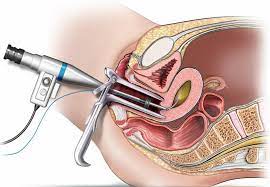Laparoscopic Hysterectomy cost in India
The cost of Laparoscopic Hysterectomy in India
ranges from USD 3500 to USD 7500
Procedure Description:
Laparoscopic Hysterectomy
Laparoscopic hysterectomy is a type of vaginal hysterectomy that uses a thin, flexible tube called a laparoscope that has a video camera inside of it. Small abdominal incisions made in the vicinity of the navel are used to introduce thin tubes. After that, the uterus is removed in parts either by the vagina or the laparoscope tube.
Disease Overview:
Pelvic inflammatory disease
PID can be caused by a variety of bacteria, however the most frequent are gonorrhoea and chlamydia infections. Typically, these microorganisms are obtained through unprotected intercourse.
Pain in your lower abdomen and pelvis, which can range from minor to severe.
Being a sexually active young lady under the age of 25
Having more than one sexual partner
Being in a sexual relationship with someone who has several sexual partners
Having a sexual encounter without using a condom
Douching on a frequent basis might throw off the balance of healthy vs bad bacteria in the vaginal area, masking symptoms.
Having a sexually transmitted illness or a history of pelvic inflammatory disease
After the placement of an intrauterine device, there is a modest increase in the risk of PID (IUD). This danger is usually limited to the first three weeks following implantation.
Disease Diagnosis
There is no one test that can identify pelvic inflammatory disease with certainty. Instead, your doctor will depend on a mix of results from the following sources:
Your medical background. Your doctor would most likely inquire about your sexual activities, sexually transmitted illness history, and birth control technique.
An examination of the pelvis. During the exam, your doctor will look for pain and edoema in your pelvic region. Cotton swabs may also be used by your doctor to collect fluid samples from your vaginal and cervix. The samples will be examined in a laboratory for symptoms of illness as well as organisms like gonorrhoea and chlamydia.
Tests of the blood and urine. These tests can detect pregnancy, HIV, and other sexually transmitted illnesses, as well as evaluate white blood cell counts and other infection or inflammatory indicators.
Ultrasound. Sound waves are used to make pictures of your reproductive organs in this exam.
If your doctor is still unsure about the diagnosis, he or she may suggest more testing, such as:
Laparoscopy. Your doctor will introduce a tiny, illuminated tool via a small incision in your abdomen to observe your pelvic organs during this operation.
Biopsy of the endometrium. Your doctor will put a tiny tube into your uterus to extract a small sample of endometrial tissue during this operation. Signs of infection and inflammation are looked for in the tissue.
Disease Treatment:
The infection that causes pelvic inflammatory disease can be cured with prompt medical therapy. However, any scarring or damage to the reproductive system produced by PID cannot be reversed. The following are the most common treatments for PID:
Antibiotics. Your doctor will prescribe a course of antibiotics that you should begin taking right away. Your doctor may change your medication based on the findings of your blood tests to better match the infection's cause. After three days, you'll probably see your doctor to make sure the medication is working. Even if you start to feel better after a few days, make sure you take all of your prescription.
Your partner's treatment. Your sexual partner or partners should be evaluated and treated to prevent reinfection with a STI. Infected partners may not show any signs at all.
Abstinence for a limited time. Avoid sexual activity until your therapy is finished and your symptoms have gone away.
You may need hospitalization if you're pregnant, extremely unwell, have a suspected abscess, or haven't responded to oral treatments. Antibiotics may be given intravenously, followed by antibiotics taken orally.
Surgery is only required in rare cases. Your doctor may drain an abscess if it ruptures or threatens to rupture. If you don't react to antibiotics or have a doubtful diagnosis, such as when one or more of the signs or symptoms of PID aren't present, you may need surgery.
Country wise cost comparison for Laparoscopic Hysterectomy:
| Country | Cost |
|---|---|
| India | $3960 |
| Thailand | $3515 |
| Iran | $2404 |
| Egypt | $3202 |
| Canada | $5526 |
Treatment and Cost
12
Total Days
In Country
- 2 Day in Hospital
- 2 No. Travelers
- 10 Days Outside Hospital
Treatment cost starts from
$4400
Popular Hospital & Clinic
Featured Hospital
0 Hospitals
Related Packages
More Related Information
Some of the top rated hospitals are:
- Turkey
- Kolan International Hospital, Sisli
- Istinye University Bahcesehir Liv Hospital
- Istinye University Medical Park Gaziosmanpasa Hospital
- I.A.U VM Medical Park Florya Hospital
- Altinbas University Medical Park Bahcelievler Hospital
- Medical Park Antalya Hospital
- Medical Park Tarsus Hospital, Mersin
- Thailand
- Bangpakok 9 International Hospital
- Bumrungrad International Hospital
- Bangkok Hospital
- Bangkok International Hospital
- Samitivej Hospital
- BNH Hospital
- Aek Udon International Hospital
- Phuket International Hospital
- Bangkok Christian Hospital
- Thonburi Hospital
- Kasemrad Hospital Sriburin
- Canada
- Toronto General Hospital
- Jewish General Hospital
- Montreal General Hospital (McGill University Health Centre)
- Royal Jubilee Hospital (RJH)
- The Royal Victoria Hospital (McGill University Health Centre)
- Centre hospitalier de l’Université de Montréal (CHUM)
- Victoria General Hospital
- St Michaels Hospital Toronto
- Hamilton General Hospital
- MCMASTER UNIVERSITY MEDICAL CENTRE
- University of Ottawa Heart Institute




